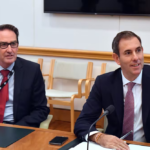
In his address to the National Press Club, Bill Ferris explains why innovation should be celebrated and encouraged in Australia, not feared or tiptoed around like some “elephant in the room”.
It is an honour for me as Chair of Innovation and Science Australia to describe the key elements and recommendations of our report to Government entitled “Australia 2030: Prosperity through Innovation”.
This Report includes 30 recommendations for how Australia can become a top tier innovative nation by 2030.
My late father, Chum Ferris, would have loved to have his say about all of this. As a young teenager he tinkered with and repaired all manner of domestic devices powered by that amazing disruptor of his time, electricity and by 1932 he had scraped together enough pocket money to fund a start-up business in Sydney, repairing and manufacturing home radio receivers.
He went on to design and introduce Australia’s first portable car radio, able to run on its own 6V battery, the car’s 12V system, and the home’s 240 volt system. The Ferris Car Radio was a new-to-market, high quality product which tapped into the expansionary boom of car ownership and lifestyle wishes in a post war industrialising Australia.
By the late 60’s the Ferris Brothers company employed more than 700 workers nationally.
Dad’s innovation and entrepreneurship inspired my own start-up in 1970 – Australia’s first venture capital company set up to back entrepreneurs like Chum. As a venture capital and private equity investor, I‘ve worked with hundreds of Australian entrepreneurs and their businesses, including some wonderful success stories like the high speed shipbuilder Austal Ships, and the on-line recruitment and training company SEEK.
I have seen versions of my father’s story play out again and again. A great idea becoming a business that creates jobs and grows. Inventors and entrepreneurs solving problems and changing people’s lives for the better.
This is the powerful, transformative impact of innovation.
And so it has been a privilege to be asked to chair ISA with its exceptional board of innovation practitioners, educators, scientists, entrepreneurs and venture capitalists to help design a national plan to significantly improve our innovation system.
Why innovation matters in Australia
Innovation is the key to a sustainable prosperity less dependent upon the performance of our commodities exports and historically favourable terms of trade, and more widely driven by the development and commercialisation of our own ideas and inventiveness.
Innovation drives productivity, which drives GDP growth which drives living standards. And fast-growing companies that innovate, export and scale are responsible for virtually all new net jobs in the economy.
History shows us that in the long term the places that practice innovation – new and better ways of making things and delivering services at home and abroad – are the ones that keep creating sustainable jobs and prosperity.
A great example is provided by a Melbourne based company, Textor Technologies, which we feature as a case study in our plan. “An overnight success after its first 10 years”, is how a CSIRO colleague recently described this most innovative business. Once a struggling small manufacturer, it is now supplying its clever moisture absorption fabrics for many hundreds of millions of nappies produced by Kimberley Clark in facilities here and worldwide.
Textor worked with CSIRO to develop novel fabrics, and upgraded its Tullamarine factory to a state-of-the-art, automated facility. In doing so, all staff were retrained to perform higher value roles. These innovations have transformed Textor into a healthcare and hygiene leader, exporting across the Asia Pacific. The business has grown by 300%, and has opened up a multinational textile value chain.
Stories like this highlight why innovation should be celebrated and encouraged in Australia, not feared or tip-toed around like some “elephant in the room”. Australians are smart enough to know that new technology is inevitable; and most already understand that innovation can enhance our competitiveness and future living standards.
ISA’s 2030 plan
The ambition and vision for our plan is for Australia to become a top tier innovation nation by 2030, known and respected for the excellence of its research, science and commercialisation, with plentiful and meaningful jobs in a fair, inclusive and healthy society.
To get there by 2030 our strategic plan calls out 5 imperatives to be tackled if Australia is to close the present considerable gap in innovation performance between it and key competitor nations.
Since the December 2015 announcement of the National Innovation and Science Agenda the supply of venture capital has increased by approximately 400%, as a direct response to the improvements in taxation incentives for High Net Worth investors, improved tax structures in the Early Stage Venture Capital Limited Partnerships program, and the creation of the $500 million Biomedical Translation Fund, and CSIRO’s $200 million Main Sequence Venture Fund.
It is the composition of this big increase in venture capital that is also encouraging, with significant lead investors now coming from a previously reluctant institutional market. I am especially pleased that we have already been able to establish the Biomedical Translation Fund, with almost half of the $500 million subscribed by several of Australia’s leading superannuation funds, matching the Government’s $250 million co-investment.
So the NISA has been a good initiative: but to significantly lift our innovation game, we need to robustly deal with the five imperatives identified in our plan.
1. Education
We need to equip our kids with skills relevant to the jobs of 2030.
In our conversations around the board table we sometimes refer to education as setting the “speed limit” for our economy. Yet just at the time when Australia needs to accelerate its innovation performance, and raise its economic speed limit, we are falling behind our global peers, particularly in student performance in science, mathematics and literacy.
The data shows that while Australia has pockets of excellence in our education system, overall results in science, maths and literacy have declined in the last decade, despite increases in funding. This must be reversed.
Therefore ISA’s recommendations focus on changes necessary in secondary school curricula, quality of teaching, and student performance.
We focus on increasing teacher quality and training, noting for example that 40 percent of maths teachers are teaching “out of field” i.e. without any formal maths knowledge or training.
And given that digital literacy will be just as important in future work as basic literacy and numeracy, we support increased emphasis on STEM subjects with an expanding role for the STEM Partnerships Forum, bringing industry and education leaders together to lift student understanding and awareness of the relevance of STEM skills to a wide range of careers.
The changing nature of work in the future means that reskilling and life-long training and learning will be essential to establish a competitive workforce and to maintain a fair and inclusive society out to 2030 and beyond. The Plan therefore recognises and recommends the urgent need to restore and enhance the reputation and capability of the vocational education training (VET) sector.
2. Industry
We need to ensure Australia’s ongoing prosperity by stimulating high-growth firms and improving productivity.
Australian business simply isn’t investing in innovation, at the rate seen in the business communities of our competitor nations. And, more alarmingly, the trend in this investment has been falling since the GFC. BERD – the acronym for Business Expenditure on Research & Development – reached a highpoint of 1.3% of GDP in 2008, but fell to 1% in 2015-16.
In the same year, BERD was at 3.6% of GDP in Israel, and around 2% of GDP in both Germany and the USA. The reversal of this downward trend in R&D spending by our business is a top priority in the Plan. We need BERD to expand significantly, with something closer to 1.7% of GDP being, a reasonable aim by 2030.
To achieve this goal, the Plan includes a number of recommendations aimed at encouraging start-ups, and scale-ups like Textor, to which I referred earlier. This includes improved design of existing research and development incentives. Tax based, grants based and co-investment incentives must drive a greater bang for the government’s buck and we must make sure they are readily accessible to growth oriented companies, big and small.
So the report calls for changes in the RDTI aimed at improving the additionality and sustainability of this indirect tax program. These changes build on and refine the recommendations from the previously-published 3F’s review, commissioned by NISA and fondly referred to as the 3F’s being Fraser, Finkel and Ferris.
The Board notes that Australia’s reliance on indirect tax based incentives is out of step with other more innovative nations. Australia has only 13% of its business incentives in direct measures compared to Sweden, Germany and Israel at 100%, the US at 73% and the UK at 50%.
One key area where direct support should be expanded is in facilitating exports by Australian firms. Exports are a strong proxy for innovative and competitive performance and our plan therefore calls for an expansion of Austrade’s EMDG program. Indeed approximately 50% of the SMEs in the EMDG program are achieving better than 20% per annum growth in employees and sales.
With consumer households in Asia expected to double from 600 million today to 1.2 billion by 2030, we believe there is a large multiplier opportunity to be supported by this recommendation.
That international perspective also informs another recommendation based on the Board’s own first-hand experience that competing in the global innovation economy requires access to the best talent available. As a small part of the global community, Australia can’t expect to find all of this talent within our own shores.
It is therefore vital we have an immigration policy that can attract and retain world class talent for our innovation system. Reducing immigration of such talent will not lead to more jobs for Australians – if anything it will do the opposite: highly skilled migrants are “job multipliers” – developing skills and creating new jobs that we simply couldn’t do alone.
3. Government
Government must become a catalyst for innovation and be recognised as a global leader in innovative service delivery.
All too often the focus in the public debate on innovation is only on how Governments invest in supporting innovation, rather than how they innovate themselves.
We need a public service with contemporary skills, broad experience and an open culture. We also need to rethink the way the public service is organised, so public servants can work more effectively in cross-agency teams, rather than the current default model of policy and service silos. Such a public service could then be fit for purpose to drive greater innovation in a transformed digital economy.
Therefore, the Plan calls for a review of the Australian Government Public Service to enable a greater role and capability for innovation in policy development, implementation and service delivery.
Government activities of course constitute a sizeable share of the economy by any measure. ISA believes Australian governments can and should make greater strategic use of their role in the economy to stimulate innovation amongst SMEs and high growth firms.
The plan recommends that 33% of government procurement contracts should be awarded to SMEs by 2022, measured in dollar value. It also recommends Governments should accelerate the trial of innovative new approaches to supporting SMEs and high growth firms, such as a “government as a first customer” program.
Defence of course has the huge potential to be a pathfinder for driving spill-overs from major projects such as shipbuilding. Our report pushes for even stronger efforts in this regard and also endorses the recent DSTG allocation of $1.6 billion funding for encouraging early stage development by researchers and SMEs of novel solutions to future ADF requirements.
Australian governments are also sitting on a stockpile of rich data assets. We need to get better and faster at making high value data available, so that third party users can harness it to create new insights and services.
High quality curated data is also an essential ingredient for AI and its algorithms. This carries implications and opportunities for almost all industries, from transport to healthcare and education. And so we have recommended that the Government’s forthcoming Digital Economy Strategy paper should prioritise development of an advanced capability in AI and machine learning to ensure Australia remains globally competitive.
4. Research and Development
We must improve R&D effectiveness by increasing the translation and commercialisation of research.
Australian researchers produce world class knowledge and ideas. But we badly lag our competitor nations in commercialising this intellectual property. The level of collaboration between business and researchers is also lagging our competitors, e.g. the contribution of Australian industry to higher education R&D is just 5%, and below the OECD average.
Changing this dynamic, and unlocking the economic and social value of our best ideas both at home and through our exports to the world, is critical to lifting our innovation potential.
Our Plan recommends incentivising collaboration between researchers and businesses by adding a collaboration premium to the RDTI, encouraging more movement of researchers between industry and institutions and more businesses to reach out to our universities and other publicly funded research organisations including CSIRO and the MRI’s.
We have also recommended that the government release an Australian Innovation Precincts Statement to help shape their involvement in the emergence of local clusters of innovation around the country. One of the case studies highlighted in the report shows a glimpse of where we need to head. It tells the story of the Geelong Future Economy Precinct.
In five years since the shut-down of the auto industry, the precinct has created over 1000 jobs in advanced manufacturing, with a particular specialisation in carbon fibre technology. It brings together pioneering companies including Carbon Nexus, LeMond Composites and Carbon Revolution, and is anchored by Deakin University. Carbon Revolution supplies Ford USA with all of its carbon fibre wheels for the Mustang range. It is also developing products for the aviation sector where strength with lower weight is the holy-grail.
In addition, we have reaffirmed the need for Government to establish secure, long-term funding for national research infrastructure, which is a key foundation for our innovation system. This is in accordance with the recommendations of the 2016 National Research Infrastructure Roadmap, which was developed under the expert guidance of my colleague and ISA Deputy Chair, Chief Scientist Dr Alan Finkel.
5. Culture and Ambition
I have made a career of investing in talented Australians, both in the NFP world and in the corporate world – People who have gone on to achieve incredible things. I know ability is not the barrier to Australians succeeding globally. Where I see a big gap between Australia and the world’s leading innovation nations is in the level of our aspiration, and our willingness to tackle very big problems, at a global scale.
To help build a culture that inspires Australians to take on some of the really big challenges and to proudly celebrate their own outstanding science and innovation, the Plan recommends a program of National Missions.
Large scale initiatives, catalysed by governments that address audacious challenges; Australia has a grand tradition of such visionary projects, for example the Snowy Mountains Scheme and SKA telescope and more recently the pursuit of quantum computing led by our Australian of the Year Professor Michelle Simmons.
Such a program would invigorate the public’s excitement and imagination for science and innovation, and inspire our best thinkers and entrepreneurs to solve our greatest challenges.
ISA is recommending that the first such National Mission should be to use genomics and precision medicine to assist Australia becoming the healthiest nation on Earth. This will entail the expansion and integration of genomics and precision medicine capability into our national health and medical system.
It is a grand project. This mission would sequence the genomes of selected patient groups, including families with a history of cancer, children with rare diseases, and people with chronic disease. It would lead to better health outcomes, new and earlier diagnosis, improved prevention and more targeted and personalised care. In doing so, we can be a world leader in intelligent, efficient and cost effective health delivery.
An example of what that kind of advanced healthcare looks like is helpful: The Garvan Institute in Sydney is trialling a program for sequencing the genomes of individuals with rare conditions. A couple of years ago, one seven year old with a rare blood disorder was admitted to the trial. His condition had rapidly deteriorated and he was critically ill in hospital.
Working through the weekend, researchers at the Institute used his sequenced genome to pinpoint the genetic variation responsible for his condition. That allowed them to scan medical literature and find a new drug on trial in the US to treat patients with this same variation. Alan was out of danger in a week. Within six months, he was well enough to go to school for the first time, and able to ride a bike like other kids.
Stories like this are a reminder that we already have a good healthcare system – we are already in the top half dozen of OECD nations in terms of life expectancy, and at reasonable cost per capita. But why not aim to be great, rather than just good? Why not have a crack at becoming number 1? To become the healthiest nation on the planet. I’d call that a challenge worth taking on.
Our plan also highlights other candidate national missions including a “Save the Reef” mission to undertake the world’s largest reef restoration and eco-engineering program to optimise the chances for the survival and adaptation of the Great Barrier Reef beyond 2030. This could inspire the very best from our scientists and innovators.
The Great Barrier Reef is a global icon and crucially important environmental habitat, bringing in an estimated $6.4 billion each year to the economy and supporting 64,000 full time jobs.
Australia has made substantial forward commitments to the Great Barrier Reef , including the Reef 2050 Plan, which provides a strong base for this mission. But that Plan has so far focused on managing direct threats such as crown-of-thorns starfish and land-based run-offs. It has not proposed any response to the recent dramatic death by bleaching of up to 50% of the corals.
This is the focus for the national mission ISA promotes, which at its core adopts a climate adaptation and restoration ambition to create a possible recovery and protection strategy for the reef beyond 2030.
We are therefore especially pleased to note the Government’s decision last week to fund a research scoping and project definition phase for such a mission
In Summary
Our Report is a report to Government; but its recommendations address all sectors of the economy and all of our citizenry. Ultimately it is about what sort of country we want by 2030 and beyond.
The Report lays out a roadmap for Government action, for implementation of all 30 recommendations by 2022 and for periodic 4 yearly assessments of progress. We have selected 17 domestic and international metrics against which to measure our innovation performance in this journey out to 2030.
In only 5 of these 17 measures do we presently rank in the top quartile of nations. So we do have a long way to go. Nonetheless, I believe our recommended suite of reforms and actions will enable Australia to extend its world record run of 26 years unbroken GDP growth and become a top tier innovation nation by 2030.
Of course we cannot, and do not, leave this heavy lifting to Government alone. Indeed the thrust of our recommendations is to stimulate significant increases in business investment in innovation via leveraging strategic Government actions including education and training reform; a rebalancing over time in the mix of business incentives; accelerated innovation in Government’s own procurement practices and service delivery and leadership of national missions.
We all need to be bold and ambitious in our support of innovation as a way of life in Australia; my kids and yours, and their kids are counting on us.
Bill Ferris delivered this address to the National Press Club on January 31st 2018.














